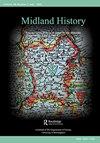Remembering the Dead Poor in the Midlands, 1750s to 1880s
IF 0.1
Q3 HISTORY
引用次数: 0
Abstract
ABSTRACT The deaths of ordinary poor people are, in both the popular imagination and much of the historiography, indelibly linked with pauper funerals, mass graves, anatomization in British medical schools and the striking absence of any of the structures and symbols of remembrance (headstones, death notices, etc.) that we often associate with other classes in 18th and 19th-century England. The dead poor under the Old and New Poor Laws were not remembered except in the sense of leaving behind poor families that might require poor relief, poor children who needed apprenticing or a life story that had to be rehearsed by surviving family members so that their place of settlement could be determined in disputed relief cases. In 2005, Elizabeth Hurren and Steven King talked about the grave and the pauper body but not about the mourners, memorialization and the memory of the dead poor. For this article, a remarkable midland’s dataset has been used to argue that remembrance of the dead poor was more systematic, sustained and meaningful than the current literature allows.纪念1750年代至1880年代中部地区的穷人
摘要普通穷人的死亡,无论是在大众的想象中,还是在大部分史学中,都与穷人的葬礼、乱葬岗、英国医学院的解剖以及我们经常与18世纪和19世纪英国其他阶层联系在一起的任何纪念结构和象征(墓碑、死亡通知等)的惊人缺失有着不可磨灭的联系。除了留下可能需要贫困救济的贫困家庭、需要学徒的贫困儿童或必须由幸存的家庭成员排练的人生故事,以便在有争议的救济案件中确定他们的定居地之外,新旧贫困法下死去的穷人没有被记住。2005年,伊丽莎白·休伦和史蒂文·金谈论了坟墓和穷人的尸体,但没有谈论哀悼者、纪念活动和对已故穷人的记忆。在这篇文章中,一个引人注目的米德兰数据集被用来证明,对已故穷人的记忆比当前文献所允许的更系统、更持久、更有意义。
本文章由计算机程序翻译,如有差异,请以英文原文为准。
求助全文
约1分钟内获得全文
求助全文

 求助内容:
求助内容: 应助结果提醒方式:
应助结果提醒方式:


